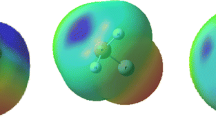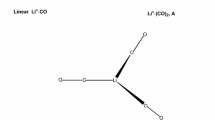Abstract
The nature of the lithium/hydrogen bonding between (CH2)2X(X: C=CH2, O, S) and LiY/HY(Y=F, Cl, Br) have been theoretically investigated at MP2/6-311++G (d, p) level, using Bader’s “atoms in molecules (AIM)” theory and Weinhold’s “natural bond orbital (NBO)” methodology. The molecule formation density differences (MFDD) of the titled complexes are analyzed. Two kinds of geometries of the lithium/hydrogen bonded complexes are compared. As a whole, the nature of lithium bond and hydrogen bond are different. For the same electron donor and the same acceptor, lithium bond is stronger than hydrogen bond. For the same electron acceptor and different kind of donors, the interaction energies follows the n-type> π-type > pseudo-π-type order. For the same (CH2)2X, the interaction energy increases in the sequence of Y=F, Cl and Br for lithium bond systems while it decreases for hydrogen bond systems. Electron transfer plays an important role in the formation of lithium bond systems while it is less important in the hydrogen bond systems.




Similar content being viewed by others
References
Kirby A (1994) Advances in physical organic chemistry. Academic, New York
Chein JCW (1984) Polyacetylene: Chemistry, physics and material science, Chap 11. Academic, New York
Klebe G (1994) J Mol Biol 237:212–235
Chandra AK, Pal S, Limaye AC, Cadre SR (1995) Chem Phys Lett 247:95–100
McDonald SA, Johnson GL, Keeler BW, Andrews L (1980) J Am Chem Soc 102:2892–2896
Curtiss LA, Blander M (1988) Chem Rev 88:827–841
Hobza PZ (1988) Chem Rev 88:871–897
Hobza KM, Sponer J, Mejzlik P, Vondrask J (1997) J Comput Chem 18:1136–1150
Ammal SSC, Venuvanalingam P (1998) J Chem Phys 109:9820–9830
Ammal SSC, Venuvanalingam P (1997) J Chem Phys 107:4329–4336
Ott H, Däschlein C, Leusser D et al (2008) J Am Chem Soc 130:11901–11911
Sannigrahi AB, Kar T, Niyogi BG (1986) Proc Indian Acad Sci Chem Sci 96:253–258
Ault BS, Pimentel GC (1975) J Phys Chem 79:621–626
Hudson AJ, Naumkin FY, Oh H et al (2001) Faraday Discuss 118:191–207
Kollman PA, Liebman JF, Allen LC (1970) J Am Chem Soc 92:1142–1150
Sannigrahi AB, Kar T, Niyogi BG et al (1990) Chem Rev 90:1061–1076
Streiwiezer A, Bachrach SM, Dorigo A et al (1995) Lithium Chem. Wiley, New York, pp 1–43
Salai C, Ammal S, Venuvanalingam P (2000) J Phys Chem A 104:10859–10867
Sapse AM, PvR S (eds) (1995) Lithium chemistry, theoretical and experimental overview. Wiley, New York, p 67
Ammal SSC, Venuvanalingam P, Paul S (1997) J Chem Phys 107:4329–4336
Ammal SSC, Venuvanalingam P, Paul S (2000) J Chem Phys 104:10859–10864
Kisiel Z, Fowler PW, Legon AC (1995) Chem Phys Lett 232:187–191
Kisiel Z, Fowler PW, Legon AC (1994) J Chem Phys 101:4635–4643
Legon AC, Rego CA, Wallwork AL (1992) J Chem Phys 97:3050–3059
Evans CM, Hollowa JH, Legon AC (1997) Chem Phys Lett 267:281–287
Kisiel Z, Fowler PW, Legon AC (1997) J Chem Soc Faraday Trans 93:4253–4258
Boys SF, Bernardi F (1970) Mol Phys 19:553–566
Frisch MJ, Trucks GW, Schlegel HB et al. (2004) Gaussian 03, Revision D.01. Gaussian Inc, Wallingford CT
Bader RFW (1990) Atoms in molecules: A quantum theory. Clarendon, Oxford, UK
Reed AE, Curtiss LA, Weinhold F (1988) Chem Rev 88:899–926
Biegler-König F (2000) AIM 2000, Version 1.0. University of Applied Science, Bielefeld, Germany
Zheng SJ, Cai XH, Meng LP (1995) QCPE Bull 15:25–28
Zou JW, Jiang YJ, Guo M et al (2005) Chem Eur J 11:740–747
Politzer P, Murray JS, Peralta-Inga Z (2001) Int J Quantum Chem 85:676–684
Politzer P, Laurence PR, Jayasuriya K (1985) Environ Health Prospect 61:191–202
Murray JS, Politzer P (1998) J Mol Struct THEOCHEM 425:107–114
Politzer P, Murray JS (1999) Trends Chem Phys 7:157–165
Hagelin H, Brinck T, Berthelot M et al (1995) Can J Chem 73:483–488
Koch U, Popelier PLA (1995) J Phys Chem 99:9747–9754
Popelier PLA (2000) Atoms in molecules. An introduction. Prentice Hall, Harlow, UK
Popelier PLA (1998) J Phys Chem A 102:1873–1878
Bader RFW, Nguyen-Dang TT, Tal Y (1981) Rep Prog Phys 44:893–948
Pimentel GC, McClellan AL (1960) The hydrogen bond. Freeman, San Francisco
Cremer D, Kraka E (1984) Angew Chem Int Ed Engl 23:627–628
Jenkins S, Morrison I (2000) Chem Phys Lett 317:97–102
Zheng SJ, Hada M, Nakastuji H (1996) Theor Chim Acta 93:67–75
Acknowledgments
This project was supported by the National Natural Science Foundation of China (Contract NO: 20771033, 20801017, 20973053), the Natural Science Foundation of Hebei Province (Contract NO. B2008000141, B2008000138), the Education Department Foundation of Hebei Province (NO.2007123, 2009137, 2009138) and the Foundation of Hebei Normal Univeristy(L2008B06, L2009Y06).
Author information
Authors and Affiliations
Corresponding author
Rights and permissions
About this article
Cite this article
Li, X., Zeng, Y., Zhang, X. et al. Insight into the lithium/hydrogen bonding in (CH2)2X...LiY/HY (X: C=CH2, O, S; Y=F, Cl, Br) complexes. J Mol Model 17, 757–767 (2011). https://doi.org/10.1007/s00894-010-0768-7
Received:
Accepted:
Published:
Issue Date:
DOI: https://doi.org/10.1007/s00894-010-0768-7




